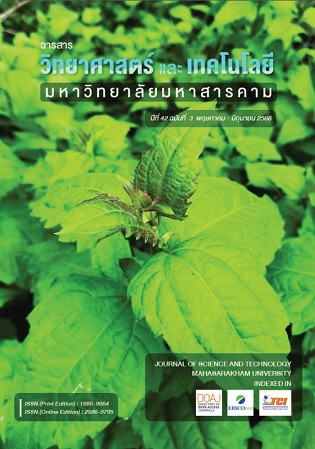Effect of brewing temperature, time and method of tea infusion on phenolic compounds, tannins, flavonoids and antioxidant activity in Ventilago denticulata Willd. herbal tea
Main Article Content
Abstract
This study aimed to investigate the effect of brewing temperature (70, 80, 90 and 100 oC), time (1, 3, 5, 10 and 15 minutes) and method of tea infusion (bagged tea, potted tea and filtered tea) on phenolic compounds, tannins, flavonoids and antioxidant activity in Ventilago denticulata Willd. herbal tea. The results revealed that total phenolics, tannins, flavonoids and %DPPH radical scavenging activity increased significantly with increasing brewing temperature and time, with the maximum condition at 100 oC within 10 minutes. After this brewing time, almost of the chemicals content were not significant difference (p>0.05). Furthermore, phytochemical contents in bagged tea were greater than those of potted and filtered tea (p<0.05), respectively. Pearson correlation coefficient showed that total phenolics, tannins, flavonoids and antioxidant activity extremely correlated with brewing time and temperature (r > 0.8). In conclusion, the results of this study gave the best brewing conditions for Ventilago denticulata Willd. herbal tea in order to optimize the extraction of phenolics, tannins, flavonoids and antioxidant activity. Consequently, the color and sensory acceptance of the consumers at these conditions are the further interesting study.
Article Details
References
ปิยาภัทร ไตรสนธิ. (2560). ชา: เครื่องดื่มเพื่อสุขภาพและสุนทรียภาพ. อาหาร, 47(4), 12-18.
รวินิภา ศรีมูล พิริยาภรณ์ อันอาตม์งาม และ วิทยา คณาวงษ์. (2561). ประสิทธิภาพการยับยั้งเอนไซม์แอลฟากลูโคซิเดสและแอลฟาอะไมเลสของสารสกัดจากใบชาขลู่ในหลอดทดลอง. วารสารวิจัยมหาวิทยาลัยเทคโนโลยีราชมงคลตะวันออก, 11(1), 1-8.
อนงค์ ศรีโสภา และ กาญจนา วงศ์กระจ่าง. (2562). การพัฒนาสูตรชาสมุนไพรใบหม่อนผสมสมุนไพรให้กลิ่นหอมที่มีฤทธิ์ต้านอนุมูลอิสระและฤทธิ์ต้านเอนไซม์กลูโคซิเดส. Thai Journal of Science and Technology, 9(2), 218-229.
Akyuz, S. & Yarat, A. (2010). The pH and neutralisable acidity of the most-consumed Turkish fruit and herbal teas. Journal of Oral Health and Dental Management (OHDMBSC), 10(2), 75-78.
Cabrera, C., Giménez, R. & López, M.C. (2003). Determination of tea components with antioxidant activity. Journal of Agricultural and Food Chemistry, 51, 4427-4435.
Castiglioni, S., Damiani, E., Astolfi, P. & Carloni, P. (2015). Influence of steeping conditions (time, temperature, and particle size) on antioxidant properties and sensory attributes of some white and green teas. International Journal of Food Sciences and Nutrition, 66, 491-497.
De Lourdes Reis Giada, M. (2013). Chapter 4: Food phenolic compounds: main classes, sources and their antioxidant power. In Morales-González, J. A. (Ed.), Oxidative stress and chronic degenerative disease-A role for antioxidants (pp. 87-111). InTech Open.
Faculty of Pharmacy Mahidol University. (1996). Lanna Traditional Herbs. Amarin Printing and Publishing.
Friedman, M. & Jürgens, H.S. (2000). Effect of pH on the stability of plant phenolic compounds. Journal of Agricultural and Food Chemistry, 48, 2101-2110.
Kumamoto, M., Sonda, T., Nagayama, K. & Tabata, M. (2001). Effects of pH and metal ions on antioxidative activities of catechins. Bioscience, Biotechnology, and Biochemistry, 65(1), 126-132.
Labbé, D., Tremblay, A. & Bazinet, L. (2006). Effect of brewing temperature and duration on green tea catechin solubilization:basis for production of EGC and EGCG-enriched fractions. Separation and Purification Technology, 49, 1-9.
Liu, Y., Luo, L., Lia, C., Chen, L., Wang, J. & Zeng, L. (2018). Effects of brewing conditions on the phytochemical composition, sensory qualities and antioxidant activity of green tea infusion: a study using response surface methodology. Food Chemistry, 269, 24-34.
Malla, M.Y., Sharma, M., Saxena, R.C., Mir, M.I., Mir, A.H. & Bhat, S.H. (2013). Phytochemical screening and spectroscopic determination of total phenolic and flavonoid contents of Eclipta Alba Linn. Journal of Natural Product and Plant Resources, 3(2), 86-91.
McKay, D.L. & Blumberg, J.B. (2006). A review of the bioactivity and potential health benefits of chamomile tea (Matricaria recutita L.). Phytotherapy Research, 20, 519-530.
Navarra, M., Mannucci, C., Delbò, M. & Calapai, G. (2015) Citrus bergamia essential oil: from basic research to clinical application. Frontiers in Pharmacology, 6, 36-36.
Pérez-Burillo, S., Giméneza, R., Rufián-Henares, J.A. & Pastoriza, S. (2018). Effect of brewing time and temperature on antioxidant capacity and phenols of white tea: relationship with sensory properties. Food Chemistry, 248, 111-118.
Shad, M.A., Nawaz, H., Rehman, T., Ahmad, H.B. & Hassain, M. (2012). Optimization of extraction efficiency of tannins from Cichorium intybus L: application of response surface methodology. Journal of Medicinal Plants Research, 28, 4467-4474.
Shimada, K., Fujikawa, K., Yahara, K. & Nakamura, T. (1992). Antioxidative properties of xanthans on the autoxidation of soybean oil in cyclodextrin emulsion.Journal of Agricultural and Food Chemistry, 40(6), 945-948.
Srimoon, R., Anartgnam, P. & Tilarux, P. (2020). In vitro inhibitory efficiency of Ventilago denticulata Willd. dried leaves extract on alpha-glucosidase, alpha-amylase and lipase and antioxidant activities. Science & Technology Asia, 25(4), 135-149.
Veljković, J.N., Pavlović, A.N., Mitić, S.S., Tošić, S.B., Stojanović, G.S., Kaličanin, B.M., Stanković, D.M., Stojković, M.B., Mitić, M.N. & Brcanović, J.M. (2013). Evaluation of individual phenolic compounds and antioxidant properties of black, green, herbal and fruit tea infusions consumed in Serbia: spectrophotometrical and electrochemical approaches. Journal of Food and Nutrition Research, 52(1), 12-24.
Vuong, Q.V. (2014). Epidemiological evidence linking tea consumption to human health: a review. Critical Reviews in Food Science and Nutrition, 54, 523-536.
Wang, H., Provan, G.J., & Helliwell, K. (2000). Tea flavonoids: their functions, utilisation and analysis. Trends in Food Science & Technology, 11, 152-160.
Wong, S.P., Leong, L.P. & Koh, J.H.W. (2006). Antioxidant activities of aqueous extracts of selected plants. Food Chemistry, 99,775-783.
Yu, J., Liu, Y., Zhang, S., Luo, L. & Zeng, L. (2021). Effect of brewing conditions on phytochemicals and sensory profiles of black tea infusions: a primary study on the effects of geraniol and β-ionone on taste perception of black tea infusions. Food Chemistry, 354, 129504.


